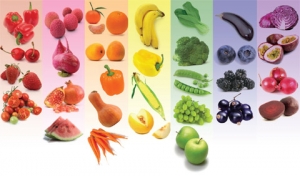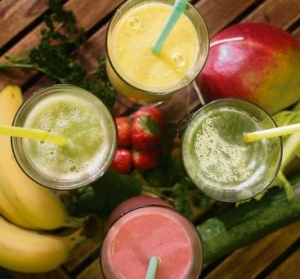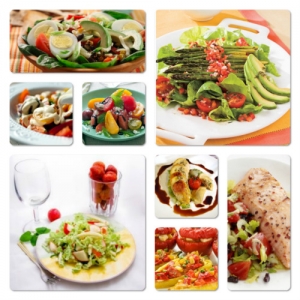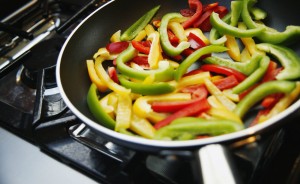Welcome to week three of the Six Weeks to a Healthy Diet course.
This week I’ll teach you about fruits and vegetables. Eating more fruits and vegetables is a sure way to improve your diet.
Week 3 – Adding Fruits and Vegetables
According to surveys done by the American Dietetic Association, only about 14% of Americans eat enough fruits and vegetables, which is at least five servings per day. This week, you’re going to focus on eating more fruits and vegetables every day. It’s really difficult to imagine a healthy diet that doesn’t include lots of fruits and vegetables.
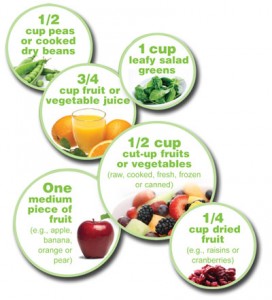 So how big is a serving?
So how big is a serving?
Generally, one serving of a fruit or vegetable is equal to about one-half cup (sliced or chopped). But greens like spinach and lettuce have a serving size equal to one full cup. A single piece of fruit, such as an apple or an orange also counts as one serving. When you read the labels on packaged fruits and vegetables, you might see that a serving is 3/4 cup instead of a half cup (usually for green vegetables such as green beans and broccoli, which are low in calories). One serving of fruit or vegetable juice is four ounces.
Remember that five servings is minimal. And if you’re a larger person, you’ll need more than five servings. Since most fruits and vegetables are low in calories, you really don’t need to worry about eating too many. But you do need to pay attention to how you serve and prepare them so you don’t ruin the good nutrition by over-cooking or by adding too much unhealthy fat or extra calories.
Getting Your Servings Into Your Diet
First, you need to know how many fruits and vegetables you normally eat every day, so take a look at your food diary. Count the servings of fruits and vegetables you eat, not counting items like French fries, apple strudel, pumpkin pie, etc. I know they are made with fruits and vegetables, but all the fat and sugar turns them into unhealthy foods. So they don’t count toward your daily servings here.
If you look at your daily total and you see more than five fruits and vegetables every day, then congratulations, you’re doing a great job, especially if you’re eating more than seven or eight servings of fresh, whole fruits and vegetables every day. If your daily total is less than five, then you’re going to focus on adding more fruits and vegetables into your diet this week. You can add some berries to your breakfast cereal, have a big salad for lunch, or serve two side dishes at dinner.
If you’re not used to eating many fruits or vegetables every day, you could probably use a few tips to get you started.
You might want to focus on some of the healthy fruits and berries, which are sweet and delicious (and perfect to eat now that you’ve cut all that extra sugar out of your diet from week 2).
- Serve fresh berries for dessert instead of ice cream.
- Buy fresh fruit instead of cookies and pastries.
- Make your own smoothies at home with bananas, berries and a little non-fat milk.
- Add raisins or other dried fruits to your oatmeal.
- Serve apple sauce as a side dish at dinner.
- Freeze grapes and eat them as a snack instead of frozen ice cream treats.
- Serve apple slices with peanut butter.
If you’re a picky eater, start with the vegetables that aren’t so bitter such as potatoes, sweet potatoes, carrots and sweet corn. But don’t give up on the green and other colorful vegetables.
Here are some tips:
Serve raw sliced vegetables with vegetable dip instead of tortilla or potato chips
- Add 1/2 cup salsa to a baked potato instead of cheese or sour cream
- Add extra tomatoes, cucumbers, carrots, and broccoli florets to your salad
- Making soup from a can for dinner? While it’s cooking, add extra frozen vegetables like carrots and peas
- Buy frozen vegetable blends that you steam in your microwave oven for quick side dishes
- Going for pizza? Top it with spinach, peppers, olives and tomatoes instead of pepperoni and sausage.
Fruits and vegetables contain the most nutrients when they are fresh. Once they are peeled, sliced, or cooked, they lose some of their nutrients. That doesn’t mean cooked fruits and vegetables are bad for you, just not optimum. There are some differences in cooking methods, which impact how you can retain the most nutrients.
In general, cooking methods that use the least amount of heat exposure (both time and temperature) retain the most nutrients. For example, steaming vegetables retains more nutrients than boiling, and stir-frying is better than roasting, pan-frying or slow-cooking. Not all nutrients are lost during cooking. Usually vitamin C and some of the B vitamins are the biggest victims. Interestingly, some of the phytochemicals like lycopene in tomatoes and anthocyanins in blueberries actually become more concentrated when cooked.
 Here are some tips:
Here are some tips:
- Don’t peel or cut your fresh fruits or vegetables until you are ready to eat or cook them.
- Steam vegetables with a steamer basked in a large sauce pan or with an electric vegetable/rice steamer
- If you boil your vegetables, use the remaining broth in a sauce or soup. Microwave your vegetables in microwave-safe dishes or special packaging meant for microwave steaming.
You should also pay attention to any extra sauces or toppings you add to your fruits and vegetables, especially if you are concerned about losing weight. Many sauces contain added sugar or unhealthy fats. It’s OK to use a little sauce to add flavor, but don’t overdo it. You can also season your vegetables with herbs and spices.
Time to eat more fruits and vegetables, so choose a goal similar to one of these:
I will eat a piece of fresh fruit instead of a candy bar or other sweet dessert at least three days or more this week.
I will eat a vegetable with dinner and lunch three days this week or more.
Continue to use your food diary. It will help you keep track of how you are progressing.
Your next lesson will help you understand fats – which ones are good and which ones are bad. Next Lesson: Six Weeks to a Healthy Diet Week 4 Choosing Fats
Fruits and Vegetables Quiz
Ready to test your knowledge on fruits and Vegetables? Take this quiz before moving on to lesson 4 next week.
1) It is important to eat fruits and vegetables every day.
a. True
b. False
2) What is the least number of servings of fruits and vegetables needed every day?
a. 1
b. 2
c. 4
d. 5
3) Dietary supplements are just as good as fruits and vegetables for preventing disease.
a) True
b) False
4) French fries are a healthy way to serve potatoes.
a. True
b. False
5) Dietary fiber found in fruits and vegetables helps keep your digestive system healthy.
a. True
b. False
6) Which reason is NOT true?
a. Most fruits and vegetables are high in vitamins and minerals.
b. Most fruits and vegetables are high in calories.
c. Most fruits and vegetables contain phytochemicals.
d. Most fruits and vegetables are high in fiber.
7) Which way is NOT a good choice as a fruit serving?
a. Apple sliced with peanut butter
b. Dish of fresh berries
c. Apple pie with ice cream
d. Pear slices on a green salad
8) Fruits and vegetables are rich in vitamins and minerals.
a. True
b. False
9) Which method is best for cooking vegetables?
a. Boiling
b. Steaming
c. Roasting
d. Slow cooking
Fruits and Vegetables Quiz Answers
1) It is important to eat fruits and vegetables every day. The correct answer is “a” True.
2) What is the least number of servings of fruits and vegetables needed every day? The correct answer is “d” 5.
3) Dietary supplements are just as good as fruits and vegetables for preventing disease. The correct answer is “b” False.
4) French fries are a healthy way to serve potatoes. The correct answer is “b” False.
5) Dietary fiber found in fruits and vegetables helps keep your digestive system healthy. The correct answer is “a” True.
6) Which reason is NOT true? The correct answer is “b” .Most fruits and vegetables are high in calories.
7) Which way is NOT a good way to serve fruit? The correct answer is “c” Apple pie with ice cream.
8) Fruits and vegetables are rich in vitamins and minerals. The correct answer is “a” True.
9) Which method is best for cooking vegetables? The correct answer is “b” Steaming


